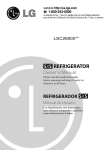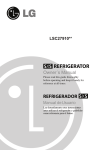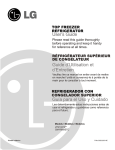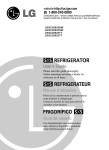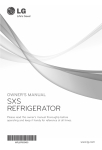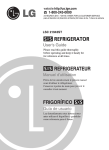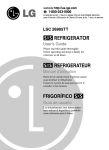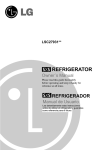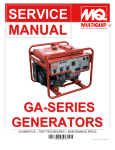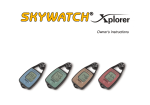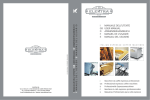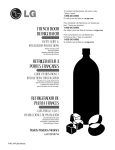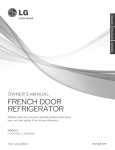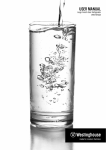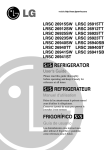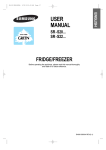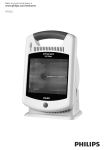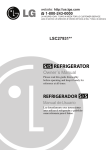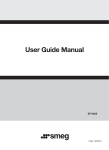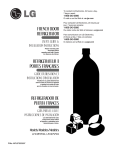Download REFRIGERATOR
Transcript
LSC26905**
REFRIGERATOR
Owner´s Manual
REFRIGERADOR
Table of Contents
Introduction
Installation
Operation
Suggestion on
Food Storage
Care and
Maintenance
2
Entry
3
Important Safety Instruction
3
Identification of Parts
6
Where to Locate
6
Door Removal
8
Door Replacement
9
Water Pipe Installation
9
Water Connection Instruction Guide
9
Operation Instruction Guide
10
Height Adjustment
12
Starting
13
Adjusting the Temperatures and functions
(Dispenser/Automatic Icemaker)
13
Shelf
17
Location of Foods
18
Storing Foods
19
How to Dismantle Parts
20
General Information
22
Cleaning
22
Troubleshooting
23
Introduction
Entry
The model and serial numbers are found on the inner case or back of refrigerator
compartment of this unit. These numbers are unique to this unit and not
available to others. You should record requested information here and retain
this guide as a permanent record of your purchase. Staple your receipt here.
Date of purchase :
Dealer :
Dealer address:
Dealer phone no. :
Model no.:
Serial no.:
Important safety
Instructions
SAFETY MESSAGES
This guide contains many important safety messages. Always read and obey
DANGER
You will be killed or seriously injured if you don’t follow instructions.
WARNING You can be killed or seriously injured if you don’t follow instructions.
CAUTION Indicates an imminently hazardous situation which, if not avoided,
may result in minor or moderate injury, or product damage only.
All safety messages will identify the hazard, tell you how to reduce the chance of injury
and tell you what can happed if the instructions are not followed.
WARNING
To reduce the risk of fire, electric shock or injury to persons when using your
product, basic safety precautions should be followed, including the
following. Read all instructions before using this appliance:
3
NEVER unplug your refrigerator by pulling on the power cord. Always grip the
plug firmly and pull it straight out from the outlet.
Repair or replace inmediately all electric service cords that have become frayed
or otherwise damaged. Do not use a cord that shows cracks or abrasion damage
along its length or at either the plug or connector end.
When moving your refrigerator away from the wall, be careful not to roll over or
damage it in any way.
Do not crush or damage the water line.
Do not store or use gasoline or other flammable vapors and liquids in the vicinity
of this or any other appliance.
Do not allow children to climb, stand, or hang on the refrigerator doors or
shelves in refrigerator. They could damage the refrigerator and seriously injure
themshelves.
Keep fingers out of “pinch point” areas; clearances between the doors and
cabinet are necessarily small. Be careful when you open the doors when children
are in the area.
Unplug your refrigerator before cleaning or making any repairs.
NOTE: We strongly recommend that any servicing be performed by a qualified
individual.
Introduction
Before replacing a burned-out light bulb, unplug the refrigerator or turn off power
at the circuit breaker or fuse box in order to avoid contact with a live wire filament.
(A burned-out light bulb may break when being replaced). NOTE: Setting either or
both controls to the OFF position does not remove power to the light circuit.
Do not store bottles in the freezer compartment they may break when frozen,
causing damage.
The refrigerator-freezer should be so positioned that the supply plug is accessible
for quick disconnection when accident happens.
For personal safety, this appliance must be properly grounded. Have the wall
outlet and the circuit checked by a qualified electrician to make sure the outlet is
properly grounded.
This refrigerator must be properly installed in accordance with the Attention
Installer Instructions that were taped to the front of the refrigerator.
After your refrigerator is in operation, do not touch the cold surfaces in the freezer
compartment when hands are damp or wet. Skin may adhere to the extremely cold
surfaces.
In refrigerators with automatic icemakers, avoid contact with the moving parts of
the ejector mechanism, or with the heating element that releases the cubes. DO
NOT place fingers or hands on the automatic icemaking mechanism while the
refrigerator is plugged in.
DO NOT refreeze frozen foods which have thawed completely. The United States
Department of Agriculture in Home and Garden Bulletin No. 69 says:
“...You may safely refreeze frozen foods that have thawed if they still contain ice
crystals or if they are still cold below 40° (4°C).”
“...Thawed ground meats, poultry, or fish that have any off-odor or off-color should
not be frozen and should not be eaten. Thawed ice cream should be discarded. If
the odor or color of any food is poor or questionable, get rid of it. The food may be
dangerous to eat.”
“Even partial thawing and refreezing reduces the eating quality of foods,
particularly fruits, vegetables and prepared foods.
The eating quality of red meats is affected less than that of many other foods. Use
refrozen foods as soon as possible to save as much of their quality as you can.”
DANGER
Child entrapment and suffocation are not problems of
the past. Junked or abandoned refrigerators are still
dangerous... even if they will sit for “just a few days”.
Risk of child
entrapment
BEFORE YOU THROW AWAY YOUR OLD REFRIGERATOR OR FREEZER
Take off the doors.
Leave the shelves in place so that
children may not easily climb inside.
CFC DISPOSAL
4
Your old refrigerator may have a cooling system that used CFCs
(chlorofuorocarbons). CFCs are believed to harm stratospheric ozone.
If you are throwing away your old refrigerator, make sure the CFC refrigerant is
removed for proper disposal by a qualified servicer. If you intentionally release
this CFC refrigerant, you can be subject to fines and imprisonment under
provisions of environmental legislation.
This appliance contains fluid (refrigerant, lubricant), is made of parts and
materials which are reusable and / or recyclable. All the important materials
should be sent to the collection center of waste material and can be reused
after rework (recycling). For take back, please contact with the local agency.
Introduction
GROUNDING IMPORTANT: Please read carefully
REQUIREMENTS TO CONNECT ELECTRICITY
WARNING
FOR PERSONAL SAFETY, this appliance must be
properly grounded. Have the wall outlet and the
circuit checked by a qualified electrician to make sure
the outlet is properly grounded.
Electrical
Shock Hazard
3-prong
grounding type
wall receptacle
3-prong
grounding
plug
Ensure proper
ground exists
before use.
RECOMMENDED GROUNDING METHOD
The refrigerator should always be plugged into its own individual properly
grounded electrical outlet rated for 115 Volts, 60 Hz, AC only and fused at 15 or 20
amperes. This provides the best performance and also prevents overloading house
wiring circuits which could cause a fire hazard from overheated wires. It is
recommended that a separate circuit serving only this appliance be provided.
Use a receptacle which cannot be turned off with a switch or pull chain. Do not use
an extension cord.
Where a standard two-prong wall outlet is encountered, it is your personal
responsibility and obligation to have it replaced with a properly grounded threeprong wall outlet.
Do not, under any circumstances, cut or remove the third (ground) prong from the
power cord.
NOTE: Before performing any type of installation, cleaning, or removing a light
bulb, turn the control (Thermostat, Refrigerator Control or Freezer Control,
depending on the model) to OFF and then disconnect the refrigerator from the
electrical source. When you are finished, reconnect the refrigerator to the electrical
source and reset the control (Thermostat, Refrigerator Control or Freezer Control,
depending on the model) to the desired setting.
USE OF EXTENSION CORDS
Because of potential safety hazards under certain conditions, we strongly
recommend against the use of an extension cord. However, if you still elect to use
an extension cord, it is absolutely necessary that it be a UL-listed (in the United
States), 3-wire grounding type appliance extension cord having a groundind type
plug and outlet, and that the electrical rating of the cord be 15 amperes (minimum)
and 120 volts.
Use of an extension cord will increase the clearance needed for the back of the
refrigerator.
If the supply cord is damaged, it must be replaced by the manufacturer or its
service agent or a similarly qualified person in order to avoid any hazard.
5
Introduction
Identification of Parts
Freezer
Compartment
Refrigerator
Compartment
Dairy Corner
Lamp 1 or 2
Door Rack
Water Filter
Automatic
Icemaker
Shelf
Lamp
Shelf
Snack Drawer
Shelf (steel)
Door Rack
Vegetable Drawer
Door Rack
Vegetable Drawer
Drawer
Door Rack
•
Lower Cover
If you find some parts missing from your unit,
they may be parts only used in other models.
Where to install
Strong
and even floor
Unstable installation may cause vibration and
noise. If the floor to install the refrigerator on
is not even, make the refrigerator level by
rotating the height adjusting screw. Carpet
or floor covering on which a refrigerator is
installed may be discolored by heat from the
bottom of the refrigerator.
If our refrigerator causes this kind of
damage, there is something wrong with it.
Customers will not stand for this.
A proper
distance from
adjacent items
Please keep the refrigerator at a proper
distance from other things. Too small a
distance from adjacent items may result in
lowered freezing capability and increased
electricity charges consumption.
6
6
More than
4"(10 cm)
to top
More than
2"(5 cm)
to back
Installation
Where water
supply can be
easily connected
in a dry place
Select a place where a water supply can be
easily connected between the automatic ice
maker and dispenser.
Installing the refrigerator in a wet or damp
area may cause rust and may be an electrical
hazard.
Bottom Pad
Where it is free
from heat
If this refrigerator is installed where the
ambient temperature is high, the freezing
capacity is deteriorated and the cost of
electricity used increases.
NOTE
•
Install the refrigerator at a place where the ambient temperature is 5˚C ~ 43˚C
(41˚F~110˚F).
Ambient temperature outside this range may cause product malfunction. Also, the
tube between the dispenser and automatic ice maker may freeze.
Method to remove protection film(Some Model)
1. Grasp the handles with both hands and push them upward to remove.
2. Entirely remove the protection film adhered to the external surface of the door.
3. Assemble the fixing bracket on both ends of the handle to the fixing bolt of the door
and lower the handle downward until it is entirely fixed.
7
6
Installation
Door removal
Warning
Electric Shock Hazard
Disconnect electrical supply to refrigerator before installing.
Failure to do so could result in death or serious injury.
If your entrance door is too narrow for the
refrigerator to pass through, remove the
refrigerator door and pass the refrigerator laterally.
Remove Lower
Cover and
Water Feed Tube
Remove the lower cover by lifting upward, and
then pull up the water feed tube while pressing
area shown in the figure to the right.
Lower Cover
Water Feed Tube
NOTE
•
Remove the
Freezer
Compartment
Door
If a tube end is deformed or abraded, trim the part away.
Disconnecting the tube under the door causes about 1.5 litters water to flow out. Please
put a large container at end of tube to prevent water from draining on to the floor.
Hinge
Cover
1) Remove the hinge cover by loosening the
screws. Disconnect all connections except
the ground line.
Connection
Wires
Earth Line
Upper Hinge
Keeper
2) Remove the keeper by rotating it counter
clockwise and then lifting the upper
hinge up .
Upper Hinge
NOTE
•
When removing the upper hinge, be careful that the door does not fall forward .
3) Remove the freezer compartment door by
lifting it upward. This time, the door should
be lifted enough for the water feed tube to
be completely pulled out.
Lower hinge
NOTE
•
Remove the
Refrigerator
Door
After removing the door, take it into the kitchen where you are installing the
refrigerator. Lay it down on a blanket and be careful to avoid damaging the water
feed tube.
1) Loosen the hinge cover screws and remove
the cover. Remove connection wire.
2) Remove keeper by rotating it clockwise and then remove the upper hinge by lifting
it up .
Connection
Wires
Upper Hinge
3) Remove the refrigerator compartment door
by lifting it up.
8
6
Lower Hinge
Keeper
Installation
Move the
Refrigerator
Push the refrigerator sideways through the
entrance door as shown in the right picture.
Door replacement
Mount the doors in the reverse order of
removal after the refrigerator is brought to
the installation area.
NOTE:
Check the direction of the lever hinge.
Correct
Incorrect
Feed water tube installation
Before
Installation
Automatic icemaker operation needs water pressure of 21.3~121psi(lb/inch2) (That
is, a 7oz. paper cup will be filled within 3 sec.).
If water pressure does not reach the rated 21.3psi(lb/inch2 ) or below, it is necessary
to purchase a separate pressure pump for normal automatic icemaking and cool
water feed.
Keep the total length of the water feed tube within 40 feet and be careful not to
bend or kink the tube. If the tube is longer than 40 feet, the icemaker and water
dispenser will not operate properly.
Install the water feed tube at a place free from heat.
Connect to potable water supply only.
Refer to instructions with water filter kit for installation.
Warning
Water Connection Instruction Guide
Connecting
the Refrigerator
to a Water Source
Read all directions carefully before you begin.
IMPORTANT
•
•
•
•
•
Tools Required
Standard screwdriver
7/16-inch and 1/2-inch open-end wrenches or two adjustable wrenches
1/4-inch nut driver
1/4-inch drill bit
Hand drill or electric drill (properly grounded)
Screwdriver
Electric drill
Adjustable wrenches
If operating the refrigerator before installing the water connection, turn icemaker
to the OFF position to prevent operation without water.
All installations must be in accordance with local plumbing code requirements.
Use copper tubing and check for leaks.
Install copper tubing only in areas where temperatures will remain above freezing.
It may take up to 24 hours for your icemaker to begin producing ice.
NOTE
9
In order to perform the water connection you will need to buy: a 1/4-inch saddle-type
shut off valve, a union, and copper tubing. Before purchasing, make sure the saddle-type
valve complies with your local plumbing codes. Do not use a piercing-type or 3/16-inch
saddle valve which reduces water flow and clogs more easily.
Installation
Connect
the Tubing to
Water Line
1. Unplug refrigerator or disconnect power.
2. Turn OFF main water supply. Turn on the nearest faucet to relieve the pressure on the
line. It may help to open an outside faucet to allow the water to drain from the line in
the house.
3. Find a 1/2-inch to 1-1/4-inch vertical COLD water pipe near the refrigerator.
NOTE
•
Horizontal pipe will work, but the following precaution must be taken: Drill on the top of the pipe
not the bottom. This will help keep water away from the drill. This also keeps normal sediment
from collecting in the valve.
4. To determine the length of copper tubing you will need, measure from the connection
on the lower left rear of the refrigerator to the water pipe. Add 7 feet (2.1m) to allow
for moving refrigerator for cleaning. Use 1/4-inch O.D. (outside diameter) copper
tubing. Be sure both ends of copper tubing are cut square.
5. Using a drill, drill a 1/4-inch hole in the cold water pipe you have selected.
6. Fasten shut-off valve to cold water pipe with pipe clamp. Be sure outlet end is solidly
in the 1/4-inch drilled hole in the water pipe and that the washer is under the pipe
clamp. Tighten packing nut. Tighten the pipe clamp screws carefully and evenly so
washer makes a watertight seal. Do not overtighten or you may crush the cooper
tubing, especially if soft (coiled) copper tubing is used. Now you are ready to connect
copper tubing.
7. Slip compression sleeve and compression nut on copper tubing as shown. Insert end
of tubing into outlet end squarely as far as it will go. Screw compression nut onto
outlet end with adjustable wrench. Do not over tighten.
8. Place the free end of the tubing into a container or zinc, and turn ON main water
supply and flush out tubing until water is clear. Turn OFF shutoff valve on the water
pipe. Coil the copper tubing as shown below.
Cold Water Pipe
Pipe Clamp
Coil of Polyethylene or
Copper Tubing
Packing Nut
Shut Off Valve
Compression Sleeve
Compression Nut
Operation Instruction Guide
Connect the Tubing
to the Refrigerator
Before making the connection to the refrigerator, be sure the refrigerator
power cord is not plugged into the wall outlet.
• If your refrigerator does not
Coil of Polyethylene or
Tubing Clamp
have a water filter, we
1/4" Cooper Tubing
1
recommend installing one. If
your water supply has sand or
particles that could clog the
1/4"
screen of the refrigerator’s
Compression
Nut
water valve. Install the filter in
the water line near the
2
refrigerator.
Ferrule
1. Remove the plastic flexible
(sleeve)
cap from the water valve.
2. Place the compression nut and
Refrigerator Connection
ferrule (sleeve) onto the end of
the tubing as shown.
10
3. Insert the end of the copper tubing into the connection as far as possible. While
holding the tubing, tighten the fitting.
6
Installation
Turn the Water On at
the Shut off Valve
Tighten any connections that leak.
Automatic Ice maker
Plug In the Refrigerator
Arrange the coil of copper tubing behind the refrigerator so it does not vibrate
against the back of the refrigerator or against the wall. Push the refrigerator
back to the wall.
Start the lcemaker
Set the icemaking stop switch to the ON position. The icemaker will not begin
to operate until it reaches its operating temperature of 15 °F (-9 °C). It will then
begin operation automatically, if the icemaking stop switch is in the ON
position.
The automatic icemaker makes 8 cubes at a time, 120/150 pieces per day.
But these quantities may vary according to circumstance, including ambient
temperature, door openings, freezer load.etc.
The Icemaker stops when the bin is full.
NOTE
•
When Icemaker
Does Not Operate
Smoothly
It is normal to hear a noise when ice drops into the bin.
The unit is newly installed
It takes about 12 hours for a newly installed refrigerator to make ice.
Ice is lumped together
If ice is not used frequently, it may lump together.
When ice is lumped together, take the ice lumps out of the ice storage bin,
break them into small pieces, and then place them into the ice storage bin
again.
When the icemaker produces too small or lumped ice, the amount of water
supplied to the ice maker must be adjusted. Contact the service center.
Power failure
Water may drop into the freezer compartment. Take the ice storage bin out and
discard all the ice. Dry the bin and replace it.
CAUTION
- The first ice and water may include particles or odor from the feed water pipe or
feed water box. Throw away the ice.
This is also necessary if the refrigerator has not been used for a long time.
- Never store beverage cans or other foods in ice storage bin for the purpose of rapid
cooling. Such actions may damage the automatic ice maker.
- Never remove the icemaker cover.
- Shake the bin occasionally to cause the ice to settle.
- Ice may pile up just around the icemaker causing the icemaker to think that the ice
storage bin is full.
- If discolored ice is dispensed, contact an Authorized Service Center immediately.
Do not use the ice or water until the problem is corrected.
11
Installation
Height adjustment
If the freezer
compartment door
is lower than the
refrigerator
compartment door
Make them level by inserting flat (
screw and rotating it clockwise (
If the freezer
compartment door
is higher than the
refrigerator
compartment door
Make them level by inserting flat ( - type) driver into the groove of the right height
adjusting screw and rotating it cl ockwise ( ).
- type) driver into the groove of the left height adjusting
).
- first method
If the freezer
compartment door
is higher than the
refrigerator
compartment door
Adjust the level when the refrigerator door is lower than the freezer door during the
use of the refrigerator.
Tool for
adjustment
- second method
Adjustment
hinge pin
Up
Down
1 , turn the keeper nut
1. Using the wide side of the tool for adjustment
(
)
clockwise to loosen the Keeper nut.
2. Using the narrow side of the tool for adjustment, turn the adjustment hinge pin
(
) clockwise or (
) counterclockwise to level the refrigerator and
freezer door.
3. After setting the level of the door, turn the keeper nut(
) counterclockwise to
tighten.
Do not force too hard to level the height. The hinge pin can be pulled out.
(Adjustable range of height is a maximum of 2" (5 cm))
CAUTION
After leveling the
door height
The refrigerator door will close smoothly by raising the front side by adjusting the
height adjusting screw. If the door does not close properly because it is improperly
adjusted, the performance of the refrigerator will be affected.
12
Operation
Starting
When your refrigerator is first installed, allow it to stabilize at normal operating
temperatures for 2-3 hours prior to filling it with fresh or frozen foods.
If operation is interrupted, wait 5 minutes before restarting.
Adjusting the Temperatures and Functions
2
1
Display Power Saving Mode
NOTE:
Images may vary between models,
display functions remain the same.
13
6
Operation
1. Buzzer sound mute Mode
The buzzer sound is set to OFF.
It activates by sounding the recognition sound of “Ding~” after pressing and
holding “Express FRZ” button more than 5 seconds.
It inactivates when resetting the mode power.
2. Display Power saving Mode
It places display in standby mode until door is opened.
Press “Freezer” and “Express FRZ” buttons simultaneously to turn all leds ON and
then OFF with the recognition sound of “Ding~” after 5 seconds.
Once the mode activates, the display is OFF. Until door is opened or display button
is pressed. When 30 seconds has elapsed after closing door or pressing button,
the display turns OFF.
To deactivate this mode is same as the activation methods. The mode inactivates
when resetting the power.
You can adjust temperature of freezer compartment and refrigerator
Compartment.
How to adjust the
temperature in
the freezer
compartment
Freezer Compartment temperature adjustment
How to adjust the
temperature in
the refrigerator
compartment
Refrigerator Compartment temperature adjustment
FREEZER
BAR
Indication
REFRIGERATOR
BAR
Indication
❇ Whenever pressing button, setting is repeated in the order of
(Middle) ➔ (Middle Strong) ➔ (Strong) ➔ (Weak) ➔ (Middle Weak).
The actual inner temperature varies depending on the food status, as the
indicated setting temperature is the target temperature, not actual temperature
within refrigerator.
Please adjust temperature as above after using refrigerator for minimum 2~3
days.
Dispenser
selection
You can select water or ice.
❇ Please select water, Crushed ice, or cubed ice by
DISPENSER
pressing
button as you desire.
❇ Please press the button gently by pushing in cup.
You will hear a clap when the ice door closes
after ice is dispensed.
DISPENSER
SELECT
•
14
6
Reference : Hold your cup in place for a couple of seconds after
dispensing ice or water so the last few drops go in
your cup instead of on the floor.
Pressing
Switch
Operation
The automatic icemaker can automatically make 8 cubes at a time,
120~150 pieces per day. This quantity may vary by circumstance, including ambient
temperature, door opening, freezer load. etc.
Icemaking stops when the ice storage bin is full.
If you don't want to use automatic icemaker, turn the icemaker switch to OFF.
If you want to use automatic ice-maker again, change the switch to ON. To switch ON/OFF
follow steps 1 & 2 in the picture.
OFF
ON
Automatic
Icemaker
2
1
NOTE
•
When ice maker
does not operate
smoothly
It is normal that a noise is produced when ice drops into the ice storage bin.
The unit is newly installed
It takes about 12 hours for a newly installed refrigerator to make ice.
Ice is lumped together
❈ If ice is not used frequently, it may lump together.
If the ice lumps together, take it out, break it apart, and put it back into the storage
bin.
When the ice maker produces too small or lumped together ice, the amount of
water supplied to the ice maker needs to adjusted. Contact the service center.
Power failure
Ice may drop into the freezer compartment. Take the ice storage bin out and discard
all the ice then dry it and place it back. After the machine is powered again, crushed
ice will be automatically selected.
Please select this function for prompt freezer.
”OFF➝ ON➝ OFF” is repeated
EXPRESS FRZ
whenever pressing
button.
EXPRESS FRZ
Express Freezer
SELECT
The arrow mark graphic remains at the
On status after flickering 4 times when
selecting Special Refrigeration On
Prompt freezer function automatically
turns off after a fixed time passes.
EXPRESS FRZ
EXPRESS FRZ
This button stops operation of different
button and dispenser function.
Locking or Release is repeated
whenever the LOCK is pressed more than 3
seconds.
Lock
Ex) In selecting
Ex) In selecting
On
Off
SELECT
LOCK
LOCK
LOCK
3 SECS
3 SECS
3 SECS
3 SECS
15
6
If you use the LOCK button, none of the other
buttons will work until you unlock them.
Ex) In selecting
Ex) In selecting
LOCK
UNLOCK
Operation
The Other
Functions
Door open warning
A warning tone will sound 3 times at thirty-second intervals if the refrigerator or freezer
door is left open for more than sixty seconds.
Please contact the local service center if warning tone continues to sound even after
closing the door.
Diagnosis (failure detection) function
Diagnosis function automatically detects failure during the normal use of refrigerator.
If your refrigerator fails, do not turn off the power. Instead, contact a local Authorized
service center or call our support line for assistance. Turning off the appliance will
make it more difficult for the service technician to determine the problem.
Water is cooled while stored in the water tank in freezer door, and then sent to the
dispenser.
Ice is made in the automatic icemaker and sent to the dispenser divided into crushed
or cubed ice.
How Ice/Cold
Water is Supplied
How to Use
Dispenser
Select among crushed ice, water, and cubed ice and press the push switch with a
glass or other container.
Water
Light the water lamp
by pressing the
selection button.
• Water will be dispensed
by pressing the push
switch with a glass.
Cubed Ice
Light the cubed ice
lamp by pressing
the selection
button.
• Cubed ice will be dispensed
by pressing the push
switch with a glass.
DISPENSER
DISPENSER
DISPENSER
SELECT
SELECT
SELECT
•
Filter Condition
(filter replacement
cycle) Display
Function
Crushed Ice
Light the crushed ice
lamp by pressing the
selection button.
• Crushed ice will be
dispensed by pressing the
push switch with a glass.
Reference : Hold your cup in place for a couple of seconds after dispensing ice or
water so the last few drops go in your cup instead of on the floor.
LED
There is a replacement indicator light for the
water filter cartridge on the dispenser.
Water filter needs replacement once every six
FILTER RESET FILTER
FILTER RESET
HOLD 3 SECS
HOLD 3 SECS
months.
Filter light comes on to let you know when to
replace filter.
After replacing the filter, press and hold the lock button more than 3seconds.
FILTER RESET, HOLD 3 SECS text turn off filter light.
Classification
Filter Status
Display
16
6
In initial Power On
Replace indicator
/ Filter RESET
light on
FILTER
Operation
Cautions
Throw away the ice (about 20 pieces) and water (about 7 glasses) first made after
refrigerator installation.
This is also necessary when the refrigerator has not been used for a long time.
Keep children away from the dispenser.
Children may play with or damage the controls.
Be careful that food does not block the ice passage.
If foods are placed at the entrance of ice passage, the
dispenser may malfunction. The passage may also become
blocked with frost if only crushed ice is used. Remove the
frost that accumulates.
Storing cans or other items in the ice bin may damage
the icemaker or the container may burst.
Never use thin crystal glass or crockery to collect ice.
Such glasses or containers may break.
Put ice first into a glass before filling water or other beverages.
Water may be splashed if ice is added to existing liquid in a glass.
Keep your hands and tools out of the ice door and passage.
You might break something or injure yourself.
Never remove the ice maker cover.
Shake the ice bin occasionally to level the ice in it.
Sometimes the ice piles up near the icemaker, causing the icemaker to misread the bin
level and stop producing ice.
If discolored ice or water is dispensed, contact an Authorized service center
immediately and discontinue use until the problem is corrected.
Never use too narrow or shallow glass.
Ice may be jammed in ice passage and, thus, the ice maker may fail.
Keep the glass at a proper distance from ice outlet.
A glass too close to the outlet may hinder ice from coming out.
Shelf
The refrigerator compartment shelf is adjustable so that you can place it at a height
according to space requirement of foods.
Shelf Height
Adjustment
2
1
3
3
1
17
6
2
Slide Shelf
Pull the shelf ahead and take it out while
lifting both front and rear part.
Fix Shelf
Lightly lift up the front part of shelf to pull it
ahead and then take it out while lifting the
rear part of shelf.
NOTE
•
Make sure the shelf is horizontal. If not, it may drop.
Suggestion on Food Storage
Location of Foods
(Refer to Identification of Parts)
Snack Drawer
Store small foods such as bread, snacks, etc.
Freezer
Compartment
Shelf
Store various frozen foods such as meat, fish,
ice cream, frozen snacks, etc.
Freezer
Compartment
Door Rack
Freezer
Compartment
Drawer
Store small packed frozen food.
Temperature is likely to increase as door
opens. So, do not store long-term food such
as ice cream, etc.
Store meat, fish, chicken, etc. after
wrapping them with foil.
Store dry.
Milk Product
Corner
Store milk products such as butter, cheese,
etc.
Refreshment
Center
Store foods of frequent use such as beverage,
etc.
Refrigerator
Compartment
Shelf
Store side dishes or other foods.
Refrigerator
Compartment
Door Rack
Store small packed food or beverages such
as milk, juice, beer, etc.
Vegetable Drawer
Store vegetables or fruits.
18
6
Suggestion on Food Storage
Storing Foods
Store fresh food in the refrigerator compartment. How food is frozen and thawed is an
important factor in maintaining its freshness and flavor.
Do not store food, which spoils easily, at low temperatures, such as bananas and
melons.
Allow hot food to cool prior to storing, placing hot food in the refrigerator could spoil
other food, and lead to higher energy consumption.
When storing the food, cover it with vinyl wrap or store in a container with a lid. This
prevents moisture from evaporating, and helps food to keep its taste and nutrients.
Do not block air vents with food. Smooth circulation of chilled air keeps refrigerator
temperatures even.
Do not open the door frequently. Opening the door lets warm air enter the refrigerator,
and cause temperatures to rise.
Never keep too much food in door rack because they may be pushed against the inner racks
and the door would not be fully closed.
Freezer
Compartment
Refrigerator
Compartment
Do not store bottles in the freezer compartment - they may break when frozen.
Do not refreeze food that has been thawed. This causes loss of taste and nutrient.
When storing frozen food like ice cream for a long period, place it on the freezer
shelf, not in the door rack.
Do not touch the cold foods or containers- especially made of metal -, with wet
hands and place glass products in the freezer compartment.
- That’s why you may have chilblains and they may be broken when their inner matters
are frozen, causing personal injury.
Avoid placing moist food in top refrigerator shelves, it could freeze from direct
contact with chilled air.
Always clean food prior to refrigeration. Vegetables and fruits should be washed and
wiped, and packed food should be wiped, to prevent adjacent food from spoiling.
When storing eggs in their storage rack or box, ensure that they are fresh, and always
store them in an upright position, which keeps them fresh longer.
NOTE
•
19
6
If you keep the refrigerator in a hot and humid place, frequent opening of the door or
storing a lot of vegetables in it may cause condensation to form. Remove the
condensation with dust free cloth.
Care and Maintenance
How to Dismantle Parts
Care and Maintenance
NOTE
•
Dismantling is done in the reverse sequence of assembly.
Be sure to unplug the power plug before dismantling and assembly.
Never apply severe force to dismantle parts. Parts may be damaged.
Freezer
Compartment
Lamp
Remove cover by pressing upward on bottom
and rotating outward .
Turn the bulb counterclockwise. Max. 40 Wbulb
for refrigerator is used and can be purchased at
a service center.
Dispenser Lamp
Seperate the lamp by pulling it out, and then
remove the lamp. Max. 15 W bulb for
refrigerator is used and can be purchased at a
service center.
Freezer
Compartment
Shelf
To remove a shelf, Lift the left part of the
shelf a bit. Lift it to the direction , push the
right part to the direction , and take it out.
Door Rack and
Support
Lift the door rack holding both sides and
pull it out to direction.
Ice Storage Bin
Lift the ice shelf as shown in the right figure
and pull it out .
Hold the ice storage bin as shown in the right
figure and pull it out while slightly lifting it .
It is recommended not to dismantle the ice
storage bin unless it is necessary.
Use both hands to remove the ice bin to avoid
dropping it.
If the ice bin does not slide into place easily,
twist the drive device slightly.
After Dispenser
Is Used
The water collector has no self-draining
function. It should be cleaned regularly.
Remove the cover by pulling the front side of
water collector cover and dry it with a cloth.
20
6
2
1
Care and Maintenance
To remove the lamp cover, press the protrusion under the lamp cover to the front and
then pull the lamp cover out.
Turn the bulb counterclockwise. Max. 40 W bulb for refrigerator is used and can be
purchased at a service center.
Lamp in
Refrigerator
Compartment
NOTE
•
Vegetable
Compartment
Cover
21
6
Be sure to remove parts from the refrigerator door when removing the vegetable
compartment, snack drawer, and refreshment center cover.
To remove the vegetable compartment
cover, pull out the vegetable compartment
a bit to the front , lift the front part of the
vegetable compartment cover as shown by
, and take it out.
2
1
Care and Maintenance
General Information
Vacation Time
During average length vacations, you will probably find it best to leave the refrigerator
in operation. Place freezable items in freezer for longer life.
When you plan to store the refrigerator, remove all food, disconnect the power cord,
clean the interior thoroughly, and Block the doors open to prevent mold and mildew.
Be certain the stored refrigerator does not present a child entrapment danger.
Power Failure
Most power failures that are corrected in an hour or two will not affect your
refrigerator temperatures.
However, you should minimize the number of door openings while the power is off.
If You Move
Remove or securely fasten down all loose items inside the refrigerator.
To avoid damaging the height adjusting screws, turn them all the way into the base.
The outside wall of the refrigerator cabinet may sometimes get warm, especially just
after installation.
Don’t be alarmed. This is due to the anti-condensation pipe, which pumps hot
refrigerant to prevent sweating on the outer cabinet wall.
AntiCondensation
Pipe
Cleaning
It is important that your refrigerator be kept clean to prevent undesirable odors. Spilled
food should be wiped up immediately, since it may acidify and stain plastic surfaces if
allowed to settle.
Use a lukewarm solution of mild soap or detergent to clean the durable finish of your
refrigerator. Wipe with a clean damp cloth and then dry.
Exterior
Interior
Regular cleaning is recommended. Wash all compartments with a baking soda
solution or a mild detergent and warm water. Rinse and dry. If you use other substances
for cleaning, your refrigerator could be damaged.
After Cleaning
Please verify that the power cord is not damaged, power plug is not overheated, or
power plug is well inserted into the power socket.
Warning
Always remove power cord from the wall outlet prior to cleaning in the vicinity of
electrical parts (lamps, switches, controls, etc.).
Wipe up excess moisture with a sponge or cloth to prevent water or liquid from
getting into any electrical part and causing an electric shock.
Never use metallic scouring pads, brushes, coarse abrasive cleaners, strong alkaline
solutions, flammable or toxic cleaning liquids on any surface.
Do not touch frozen surfaces with wet or damp hands, because damp object will stick
or adhere to extremely cold surfaces.
22
6
Care and Maintenance
Troubleshooting
Before calling for service, review this list. It may save you both time and expense.
This list includes common occurrences that are not the result of defective
workmanship or materials in this appliance.
Occurrence
Possible cause
Solution
Runing of refrigerator
Refrigerator
compressor
does not run.
Refrigerator
runs too often
or too long
Refrigerator control is off.
Set refrigerator control. See setting the
controls.
Refrigerator is in defrost cycle.
This is normal for a fully automatic
defrosting refrigerator. The defrost
cycle occurs periodically.
Plug at wall outlet is disconnected.
Make sure plug is tightly pushed into
outlet.
Power outage. Check house lights.
Call local electric company.
Refrigerator is larger than the previous
one you owned.
This is normal. Larger, more efficient
units run longer in these conditions.
Room or outside weather is hot.
It is normal for the refrigerator to work
longer under these conditions.
Refrigerator has recently been
disconnected for a period of time.
Large amounts of warm or hot food
may have been stored recently.
It takes some hours for the refrigerator
to cool down completely.
Doors are opened too frequently or too
long.
Warm food will cause the refrigerator to
run longer until the desired temperature
is reached.
Warm air entering the refrigerator
causes it to run longer. Open the door
less often.
Refrigerator or freezer door may be
slightly open.
Make sure the refrigerator is level.
Keep food and containers from
blocking door. See problem section.
OPENING/CLOSING of doors.
Refrigerator control is set too cold.
Set the refrigerator control to a
warmer setting until the refrigerator
temperature is satisfactory.
Refrigerator or freezer gasket is dirty,
worn, cracked, or poorly fitted.
Clean or change gasket. Leaks in the
door seal will cause refrigerator to run
longer in order to maintain desired
temperatures.
23
6
Care and Maintenance
Possible cause
Occurrence
Solution
Temperatures are too cold
Temperature in the
freezer is too cold
but the refrigerator
temperature is
satisfactory.
Temperature in the
refrigerator is too
cold and the freezer
temperature
is satisfactory.
Food stored in
drawers freezes.
Freezer control is set too cold.
Set the freezer control to a warmer
setting until the freezer temperature is
satisfactory.
Refrigerator control is set too cold.
Set the refrigerator control to a
warmer setting.
Refrigerator control is set too cold.
See above solution.
Temperatures are too warm
Temperatures in
the refrigerator
or freezer are
too warm.
Temperature in the
refrigerator
is too warm but
the freezer
temperature is
satisfactory.
24
6
Freezer control is set too warm.
Set the freezer or refrigerator control to
a colder setting until the freezer or
refrigerator temperature is satisfactory.
Refrigerator control is set too warm.
Refrigerator control has some effect on
freezer temperature.
Set the freezer or refrigerator control to a
colder setting until the freezer or
refrigerator temperature is satisfactory.
Doors are opened too frequently or too
long.
Warm air enters the refrigerator/ freezer
whenever the door is opened.
Open the door less often.
Door is slightly open.
Close the door completely.
Large amounts of warm or hot food
may have been stored recently.
Wait until the refrigerator or freezer
has a chance to reach its selected
temperature.
Refrigerator has recently been
disconnected for a period of time.
A refrigerator requires some hours to
cool down completely.
Refrigerator control is set too warm.
Set the refrigerator control to a colder
setting.
Care and Maintenance
Occurrence
Possible cause
Solution
Sound and noise
Louder sound
levels when
refrigerator is on.
Today’s refrigerators have increased
storage capacity and maintain more
even temperatures.
It is normal for sound levels to be higher.
Louder sound
levels when
compressor
comes on.
Refrigerator operates at higher pressures
during the start of the ON cycle.
This is normal. The sound will level off as
the refrigerator continues to run.
Vibrating or
rattling noise.
Floor is uneven or weak.
Refrigerator rocks on the floor when it is
moved slightly.
Be sure floor is level and solid and can
adequately support refrigerator.
Items placed on the top of the refrigerator
are vibrating.
Remove items.
Dishes are vibrating on the shelves in
the refrigerator.
Move dishes slightly.
Make sure refrigerator is level and firmly
set on floor.
Refrigerator is touching wall or cabinets.
Move refrigerator so that it does not
touch the wall or refrigerator.
Water/Moisture/Ice inside refrigerator
Moisture collects
on the inside walls
of the refrigerator.
The weather is hot and humid which
increases the rate of frost buildup
and internal sweating.
This is normal.
Door is slightly open.
See problem section opening/closing of
doors.
Door is opened too often or too long.
Open the door less often.
Water/Moisture/Ice outside refrigerator
Moisture forms
on the outside of
the refrigerator
or between doors.
25
6
Weather is humid.
This is normal in humid weather.
When humidity is lower, the moisture
should disappear.
Door is slightly open,causing cold air
from the inside the refrigerator to meet
warm air from the outside.
This time, close the door completely.
Care and Maintenance
Possible cause
Occurrence
Solution
Odors in refrigerator
Interior needs to be cleaned.
Clean interior with sponge,warm water
and baking soda.
Food with strong odor is in the refrigerator.
Cover food completely.
Some containers and wrapping materials
produce odors.
Use a different container or brand of
wrapping materials.
Opening/Closing of doors/Drawers
Door(s) will not
close.
Food package is keeping door open.
Move packages that keep door from
closing.
Door(s) will not
close.
Door was closed too hard, causing other
door to open slightly.
Close both doors gently.
Refrigerator is not level. It rocks on the
floor when it is moved slightly.
Adjust the height adjusting screw.
Floor is uneven or weak.
Refrigerator rocks on the floor when it
is moved slightly.
Be sure floor is level and can adequately
support refrigerator.
Contact carpenter to correct sagging or
sloping floor.
Refrigerator is touching wall or cabinets.
Move refrigerator..
Food is touching shelf on top of the
drawer
Keep less food in drawer.
Track that drawer slides on is dirty.
Clean drawer and track.
Ice storage bin is empty.
When the first supply of ice is dropped
into the bin, the dispenser should operate.
Freezer temperature is set too warm.
Turn the freezer control to a higher
setting so that ice cubes will be made.
When the first supply of ice is made,
the dispenser should operate.
Household water line valve is not open.
Open household water line valve and
allow sufficient time for ice to be made.
When ice is made, dispenser should
operate.
Refrigerator or freezer door is not closed.
Be sure both doors are closed.
Drawers are
difficult to move.
Dispenser
Dispenser will not
dispense ice
26
6
Care and Maintenance
Occurrence
Possible cause
Dispenser will
not dispense
ice.
Ice has melted and frozen around auger
due to infrequent use, temperature
fluctuations and/or power outages.
Remove ice storage bin, and thaw and
the contents. Clean bin, wipe dry and
replace in proper position.
When new ice is made, dispenser should
operate.
Ice dispenser
is jammed.
Ice cubes are jammed between the ice
maker arm and back of the bin.
Remove the ice cubes that are jamming
the dispenser.
Ice cubes are frozen together.
Use the dispenser often so that cubes do
not freeze together.
Ice cubes that have been purchased or
made in some other way have been
used in the dispenser.
Only the ice cubes made by the ice maker
should be used with the dispenser.
Household water line valve is not open.
See problem Icemaker is not making
any ice .
Open household water line valve.
Dispenser will
not dispense
water.
Solution
Refrigerator or freezer door is not closed. Be sure both doors are closed.
Water has an
odd taste
and/or odor.
Water has been in the tank for too long. Draw and discard 7 glasses of water
to freshen the supply. Draw and discard
an additional 7 glasses to completely rinse
out tank.
Unit not properly connected to cold
water line.
Sound of ice
dropping.
Sound of water
supply.
Other.
Connect unit to cold water line which
supplies water to kitchen faucet.
This sound is normally made when automatically made ice is dropped into ice storage
bin. Volume may vary according to refrigerator’s location.
This sound is normally made when ice maker is supplied with water after dropping
the automatically made ice.
Please thoroughly read Automatic icemaker and dispenser
ONLY UNITED STATES
CUSTOMER ASSISTANCE NUMBERS:
in this manual.
http://www.lgservice.com
To Prove Warranty Coverage
Retain your Sales Receipt to prove date of purchase.
A copy of your Sales Receipt must be submitted at the time warranty service is provided.
To Obtain Product, Customer or Service Assistance
Call Toll-free for Customer Service
Tel : 1-800-243-0000
To Obtain Nearest Authorized Service Center
Call 1-800-243-0000, push option #1, 24 hours a day, 7days per week.
Please have your product type (Monitor, TV, VCR, MWO, Refrigerator) and ZIP code ready.
27
6
LG ELECTRONICS, INC.
LG REFRIGERATOR LIMITED WARRANTY - USA
Your LG Refrigerator will be will repaired or replaced, at LG’s option, if it proves to be defective in material or
workmanship under normal use, during the warranty period ("Warranty Period") set forth below, effective from the date
("Date of Purchase") of original consumer purchase of the product. This warranty is good only to the original purchaser
of the product and effective only when used in the United States, including Alaska, Hawaii, and U.S. Territories.
WARRANTY PERIOD:
HOW SERVICE IS HANDLED:
REFRIGERATOR/FREEZER
In-Home Service (Except Model GR051):
LABOR: One Year from the Date of Purchase.
PARTS: One Year from the Date of Purchase.
SEALED SYSTEM (Compressor, Condenser, and
Evaporator)
LABOR: One Year from the Date of Purchase.
PARTS: Seven years from the Date of Purchase.
Replacement Units and Repair Parts are warranted
for the remaining portion of the original unit’s
warranty period.
Please retain dealer’s dated bill of sale or delivery
ticket as evidence of the Date of Purchase for proof
of warranty, and submit a copy of the bill of sale to
the service person at the time warranty service is
provided.
Please call 1-800-243-0000 and choose the
appropriate option to locate your nearest LG
Authorized Service Center. (Phones are
answered 24 hours a day, 365 days per year.)
Or visit our website at: http://www.lgservice.com
THIS WARRANTY IS IN LIEU OF ANY OTHER WARRANTY, EXPRESS OR IMPLIED, INCLUDING WITHOUT
LIMITATION, ANY WARRANTY OF MERCHANTABILITY OR FITNESS FOR A PARTICULAR PURPOSE. TO THE
EXTENT ANY IMPLIED WARRANTY IS REQUIRED BY LAW, IT IS LIMITED IN DURATION TO THE EXPRESS
WARRANTY PERIOD ABOVE. NEITHER THE MANUFACTURER NOR ITS U.S. DISTRIBUTOR SHALL BE
LIABLE FOR ANY INCIDENTAL, CONSEQUENTIAL, INDIRECT, SPECIAL, OR PUNITIVE DAMAGES OF ANY
NATURE, INCLUDING WITHOUT LIMITATION, LOST REVENUES OR PROFITS, OR ANY OTHER DAMAGE
WHETHER BASED IN CONTRACT, TORT, OR OTHERWISE. Some states do not allow the exclusion or limitation of
incidental or consequential damages or limitations on how long an implied warranty lasts, so the above exclusion or
limitation may not apply to you. This warranty gives you specific legal rights and you may also have other rights that
vary from state to state.
THIS LIMITED WARRANTY DOES NOT APPLY TO:
•
Service trips to your home to deliver, pick up, and/or install the product, instruct, or replace house fuses or
correct wiring, or correction of unauthorized repairs.
• Damages or operating problems that result from misuse, abuse, operation outside environmental
specifications or contrary to the requirements of precautions in the Operating Guide, accident, vermin, fire,
flood, improper installation, acts of God, unauthorized modification or alteration, incorrect electrical current or
voltage, or commercial use, or use for other than intended purpose.
• Repairs when your LG refrigerator is used in other than normal, single-family household use.
• Damages caused during and/or after delivery.
• Display, discount, or refurbished units purchased with scratches, dents, or defects.
The cost of repair or replacement under these excluded circumstances shall be borne by the consumer.
Proof of purchase is required and must be provided to LG in order to validate warranty.
CUSTOMER INTERACTIVE CENTER NUMBERS
To obtain Customer Assistance, Product
Information, or Dealer or Authorized Service Center
location:
TO CONTACT LG ELECTRONICS BY MAIL:
LG Customer Interactive Center
P. O. Box 240007
201 James Record Road
Huntsville, Alabama 35813
ATTN: CIC
Call 1-800-243-0000 (24 hours a day, 365 days per
year) and select the appropriate option from the menu.
Or visit our website at: http://www.lgservice.com
http://www.lge.com
P/N: MFL33759906





























